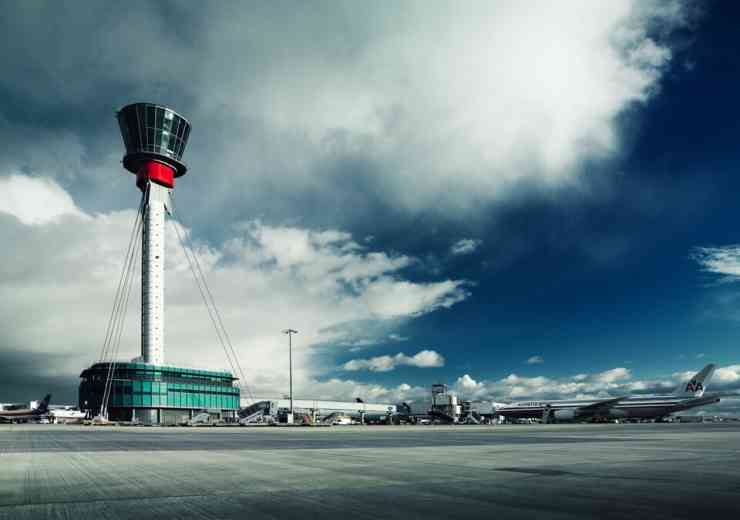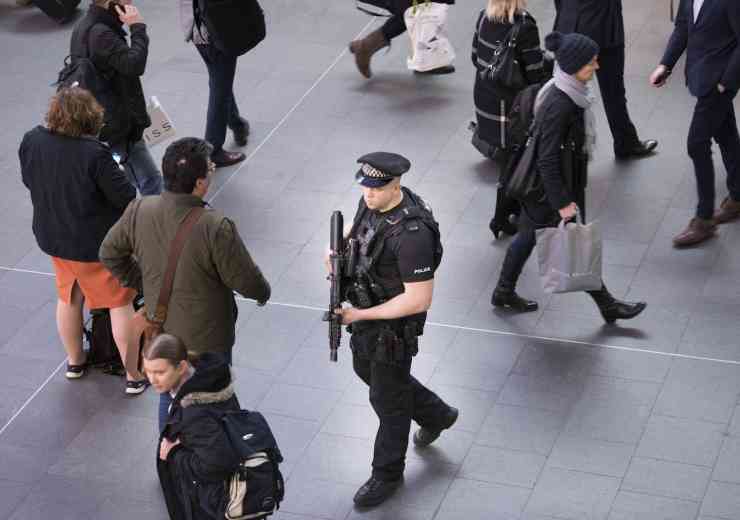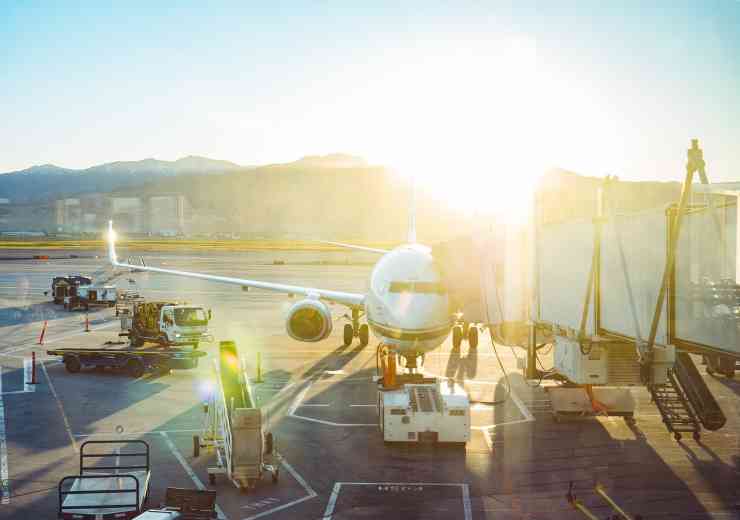A high-risk target
 The security of our nation’s airports is increasingly under the spotlight in a post-9/11 society. Many different security solutions are used to protect the people, goods and aircraft that pass through UK airports each day.
The security of our nation’s airports is increasingly under the spotlight in a post-9/11 society. Many different security solutions are used to protect the people, goods and aircraft that pass through UK airports each day.
Due to the size of airports and the high volume of people that pass through them on a daily basis, security is paramount. The safety and protection measures at airports are in a potentially very different league to other facilities. If a commercial building is broken into, the damage is probably quantifiable, but if things go wrong at an airport, the consequences may be incalculable. To best protect themselves, airports can use a combination of security measures including physical, electronic and security guarding systems, in order to achieve efficient and effective results in the combat against terrorist attacks.
Perhaps one of the most noticeable methods of security that people come across in an airport is the checks conducted on passengers and hand luggage. All hand luggage and items such as coats, handbags, laptop computers, mobile phones and cameras, undergo x-ray examination before passengers are allowed to enter the departure lounge. In addition, travellers pass through metal detectors and may be subject to a physical search.
The security guarding function is one of the most visible security solutions, as officers operate x-ray and scanning equipment and search passengers to ensure that the security of the aircraft and those onboard is not put at risk. Electronic security measures also play an essential role, with access control, CCTV and biometric technology being amongst the tools used by a modern airport.
Another important area is that of physical security, whereby gates, fencing, locks and security doors, provide vital barriers against security breaches. Many airports also rely on the services of security consultancies, which undertake risk assessments to ensure that the most appropriate security measures are used depending on the level of risk.
The BSIA Civil Aviation Security Section pools the expertise of member companies that work to secure the UK’s airports and airlines. The section focuses on exchanging best practice and cooperating with key bodies for the benefit of the industry and its customers.
Full body scanners
Recently, Manchester airport stepped up their security searches with the introduction of a full body scanner that produces images of passengers. This enables security staff to instantly spot any hidden weapons or explosives and has already been trialled in a number of airports overseas as well as Heathrow back in 2004. The Department for Transport will decide whether to install them permanently at the end of the trial at Manchester airport, which is expected to last a year.
In light of the full-body scanners recently hitting the headlines again, the British Security Industry Association (BSIA) is highlighting the importance of safety over sensationalism. Just a few weeks ago claims were made from Bollywood actor Shah Rukh Khan that on a recent trip through Heathrow Airport his scanned image was printed out and shared among staff. Following this incident, we have heard warnings from the Equality and Human Rights Commission that body scanners may be illegal because they could breach passengers’ rights to privacy.
The attempted terrorist attack that took place over Detroit on Christmas Day alone provides a stark reminder of the importance of aviation security. Technology such as full-body scanners plays a vital role in helping airport staff to maintain vigilance and carry out all-important security checks.
To better protect an individual’s privacy, full-body scanners should not work in the same manner as the hand-luggage scanners we are all used to seeing at the airport. Image analysis should be done remotely, out of sight of the scanned passenger, with systems incapable of storing, exporting or transmitting those images. All images should be automatically deleted from the systems after they have been reviewed.”
The use of full-body scanners is simply an evolution of existing security technology and allows passengers to travel safely and securely with minimum delay or disruption to their journey. With this in mind, the private security industry has welcomed the government’s support for full-body scanning technology in UK airports.
Combining this system with the likes of CCTV is effective in enhancing an airport’s security. CCTV systems are applied all over airports to closely monitor the actions of individuals and more recently, airports seem to be using the technology in baggage holds to ensure no contraband items are being added to a bag for criminal or terrorist reasons. In recent years CCTV has seen a major development in the form of Video Content Analysis (VCA). VCA is the name given to the automatic analysis of CCTV images, which is used to create useful information about the content. The technology has a wide range of uses including detecting intruders, left packages, wrongly parked vehicles and counting the number of people entering or leaving an area. Specific uses of VCA include Facial Recognition and Automatic Number Plate Recognition (ANPR). ANPR can alert security staff to the presence of vehicles returning to an area and this forewarning will allow response staff to investigate before a situation escalates.
Access control
Pairing CCTV with access control is common practice and is used to log, authenticate and track personnel movements in and out of areas. Access can be granted by photo ID cards, key fobs, swipe cards and PIN-codes through to fingerprint and other biometric-based technologies to ensure a real-time audit trail for those passing through the doors. Staff access to buildings, hangars, storage and other areas can be graded according to their seniority, using the access control system. If a staff member leaves or loses their access card/tag, a computerised electronic system can delete or replace it quickly and easily.
Protecting the perimeter of an airport is a vital security measure and can be achieved through the use of fencing, bollards, security doors and locks. Electronically monitored and physically fortified chain link fencing can alert the security team if attempts are made to climb or cut it, with ground-based detector systems capable of sensing people movement both beneath the fence and in the surrounding area. Integrating this with the use of CCTV will enable staff to zoom in and focus on a particular area, check for false alarms and direct colleagues on the ground to intercept any intruders.
Intruder alarms
Detecting intruders is an important part of airport security and intruder alarm systems can provide control room operators with the visual, audible and sequential verification that they need. This technology is also useful for detecting false alarms and saves security staff wasting time visiting an area of the site, which has not been infringed. A BSIA member worked with Doncaster’s Robin Hood International Airport to provide an Alarm Event Display system, which enables security staff to view devices and alarms via graphical maps of the airport site. In the event of an alarm, areas are highlighted red and blinking with operators then able to zoom into different layers of the maps. In the case of a violation, security staff are instantly alerted with the access control system instructing the CCTV system to display images from the nearest camera to the control room monitor.
Why choose a BSIA member?
Choosing a BSIA member to provide security solutions means selecting quality and gaining peace of mind. The BSIA is the only trade association that requires its members to be independently inspected to the quality standard ISO 9001:2000 with a UKAS accredited certification body. This provides independent assurance that a company is run consistently. The inspection also includes confirmation of compliance to relevant British and European standards and/or BSIA codes of practice.
BSIA members are at the cutting edge of standards development in the UK and Europe. Each year BSIA develops a number of its own codes of practice, which often go forward to be developed into British Standards. Customers can be confident that the products and services of BSIA members reflect the latest industry standards.
Members of the BSIA are kept up-to-date on the latest changes in the law. Therefore, you can rest assured that BSIA members are aware of the latest legislative developments and how they affect their business and yours.
Best practice is second nature to BSIA members. As an Association we are striving to increase professionalism within the industry. Our members train their employers to be up-to-date with the latest industry developments.
We are aware of the importance of long-term business relationships. That is why we look into our members’ financial records before they are admitted into membership to ensure that they are financially sound. We also vet the directors of our member companies. Vetting of all employees is a prerequisite for membership where it is relevant to the services provided. These key factors mean that our members’ customers can have peace of mind and are able to build long-tern relationships with their security suppliers.
By applying and integrating the broad span of security measures that are available, airports can continue their work to prevent and deter terrorist attacks in order to provide the very best protection to their staff and passengers.
The British Security Industry Association (BSIA) is the professional trade association of the UK security industry. Its members produce over 70 per cent of the country’s security products and services to strict quality standards.
For more information
Web: www.bsia.co.uk
Local rate helpline: 0845 389 3889
digital issue


















